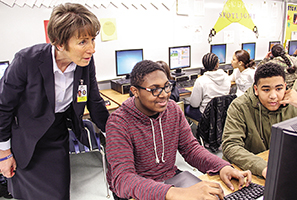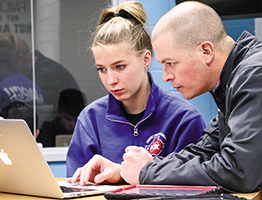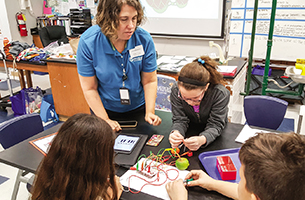
Coding: The New 21st-Century Literacy?
Computer science gains a foothold in K-12 schooling, though qualified instructors and gender imbalance remain widespread challenges
BY SCOTT LAFEE/
School Administrator, May 2017

|
| Charles County, Md., Public Schools Superintendent Kimberly Hill watches a high school freshman design a game in a computer science class. |
Last October, with notable fanfare, Google debuted Code Next, a 1,500-square-foot computer science lab in Oakland, Calif., built to foster new generations of young tech leaders, particularly girls and underrepresented minorities.
It made sense for the global technology company, which desperately needs more computer scientists — individuals who speak the language of the machines, programs and algorithms that manage much of our lives.
Google isn’t alone. Tens of thousands of computer science jobs reportedly go unfilled each year due to a trained worker shortage. But the splashy industrial-chic Code Next lab can handle only 70 9th graders making after-school visits twice a week, though Google has plans for a second lab in New York’s Harlem and promises to eventually open-source its curriculum to interested educators.
Broad Relevance
A lot of educators aren’t waiting. In recent years, there has been rising interest in teaching computer science and coding in public schools. Advocates call it the new 21st-century literacy, essential to success in a digital economy. Teaching computer science at every level, kindergarten through high school, became a national ambition of the Obama administration.
It’s hard to gauge how high the popularity wave actually is because relevant data are sparse. In a 2016 report published by Google and Gallup, 40 percent of educators surveyed (including 1,000 teachers, 9,800 principals and 2,300 superintendents) said their districts now offered at least one computer science class, up from 25 percent in 2015.
The survey reported broad, albeit not particularly clamorous, support for the value of teaching coding among students, parents, teachers and administrators.
A 2015 survey by Change the Equation, a nonprofit that promotes STEM learning, found students ranked computer science classes just behind graphic arts and performing arts in popularity, but ahead of English, math, history, science and foreign languages. The College Board reported that more high school students took the AP Computer Science A test in 2016 — nearly 55,000 — than ever before, an 18 percent increase over 2015. In 2012, fewer than 25,000 students took the exam.
“Computer science is the driver of innovation across all careers and fields, from the sciences to the arts. People see this all around them,” says Jane Margolis, a senior researcher at the UCLA Graduate School of Education and Informatics who has written on the topic. “I think what is important to stress is that computer science is not just for those who want careers in the tech sector. Rather, the new tech landscape is impacting our entire way of life — communication, entertainment, obtaining of information, political power.”
Beyond a Fad
But progress is uneven, and issues about diversity and resources remain entrenched. The Google/Gallup poll found a lack of qualified teachers and funds to be chronic barriers. More than 90 percent of U.S. schools don’t offer AP Computer Science. Educators remained worried about adding another class to an already overladen curriculum. Minorities and females continue to be under-represented — the former because they are less likely to have access to computers at school and home; the latter because social perceptions persist that computer science is a male bastion.
Shortly after Google opened its Code Next lab in Oakland, Ariel Rabkin, a fellow at the American Enterprise Institute, published a report on “delivering on computer science for all.” He acknowledged well-publicized school district initiatives in New York, Chicago and San Francisco. (The last two plan to make coding classes mandatory for all students.) But Rabkin detailed the challenges as well, not the least being that smaller districts struggle to find qualified teachers, financial backing and sustainable will.
Computer science, Rabkin concluded, was more than the latest educational fad.
“The technology sector isn’t a bubble and there’s going to be a lot of technical jobs, including and especially computer-sciencey jobs, for the foreseeable future. That’s going to maintain student and parent interest and that will keep some pressure on the schools” to expand and deepen the curricula.
Indeed, that seems to be happening. Here are three examples.
Case 1.0: Charles County Public Schools, La Plata, Md.

|
| An 8th grader at Milton M. Somers Middle School in Charles County, Md., works on coding a video game she is creating. |
Charles County Public Schools is a suburban/rural district located 25 miles south of Washington, D.C., that touts itself as one of the fastest-growing K-12 systems in the region.
Kimberly Hill grew up in the district. Her first job teaching social studies was at the district’s McDonough High School in 1986. Twenty-seven years later, she became superintendent.
“And I began to think about what my imprint would be. How would I make the district better?” she says. “We had a very strong STEM program. My predecessor had done a lot of work. To me, the next logical step was computer science, something that I believed was a transferrable skill that all kids were entitled to be exposed to and to have an opportunity to learn.”
Hill’s vision was ambitious — computer science education at every level on every campus — but the 26,400-student district lacked the know-how. In 2013, she contacted Code.org, then a brand-new nonprofit advocacy group. She formed a partnership with the organization (one of just two in Maryland) and got busy. The initial focus was on elementary students. “We wanted to really level the playing field,” she says. “You have to start at the beginning so that when a child looks at a computer class, he or she sees other students who look like them.”
Code.org provided teacher training, both face-to-face and online. Skilled teachers trained colleagues. The essential values of computer science, which Hill says are learning to think critically, analyze problems and develop solutions, were infused throughout the curriculum.
Kindergarteners got a dose by learning step-by-step processes like putting on their socks and shoes. First graders learned methodology and sequential actions by planting a seed. Middle schoolers were exposed to more complex computer science concepts. High schoolers can take a 9th-grade exploratory class for graduation credit, which Hill says has been a huge lure. “We’re able to get lots of kids into an accessible course, then hang onto them. They take more advanced courses.”
Progress is measured in multiple ways. Computer science class enrollment is growing, with improving diversity. Teachers are still asking to be trained. There are elementary school “nights of code” where 8- and 9-year-olds show their parents how to navigate a computer. “It’s a great thing to watch,” says Hill.

|
| Computer science teacher Paul Hennig works with a student in an app development course at Prospect High School in the Arlington Heights District 214 in Mount Prospect, Ill. |
Case 2.0: High School District 214, Arlington Heights, Ill.
At the same time Hill was peering into the future, Dan Weidner also was taking stock. He had moved from a high school job to the central office of District 214 in Arlington Heights, Ill., as the new director of career and technical education for the 12,000-student system.
Weidner resided more than 820 miles west of Hill, in a solidly middle-class suburb of Chicago, but his view was similar. When he pondered his students’ potential career paths, he recognized the need for trained computer scientists was obvious and dramatic.
“I believe coding is not just the next literacy, it’s today’s literacy,” Weidner says. “In order to be successful, you have to have a basic level of understanding. Not everybody needs to become a computer programmer, but that basic understanding is critical.”
Just four years ago, District 214’s efforts were hardly notable. Fewer than 250 students were enrolled in computer science courses. With financial support from the Bosch Community Fund, Weidner investigated computer science education models and decided the best course would be to infuse the instruction into the existing curriculum.
“In year one, we had teams of math teachers working alongside computer science teachers to develop different portions of the curriculum. Not just math like algebra, but coding as an additional connection,” Weidner says. “Students would learn to incorporate coding tools or thinking into their math lesson. They would learn problem solving, but also actually build code.”
To make computer science more appealing, students had the chance to participate in an iOS yearlong course where they designed and built iPhone apps. For expertise and resources, the school district partnered with Chicago-based MobileMakersEdu (
http://mobilemakers.co).
“As much as students are learning how to program the ins and outs of coding, I think the real kicker is the focus on development in the course,” says Weidner. “Students are pursuing their own concepts. They are doing what interests them, making what they want to make. … We give them the skills and expertise to start the journey.”
The enthusiasm has translated to other areas, he says, with coding students subsequently enrolling in engineering and entrepreneurial courses. Computer labs have been “Google-ized,” with soft seating, inspirational messages scrawled on walls and pods of screens.
“Students no longer all huddle around a single monitor, but divide naturally into teams based on what they’re working on or what their interests are. It’s quite intentional — a model of the real workplace.”
The district also hosts app nights periodically to showcase student work. There’s a robotics team and a Miss Maker fair.
As in Charles County, signs of progress are modest but encouraging. Enrollment in coding classes is up, as are the numbers of girls and minority students, though interest remains predominantly male. Parents of participating students are supportive.
“I’ve had conversations with parents who have no clue what their kids are talking about at dinner, but they’re excited,” Weidner says. “The future is bright.”
Case 3.0: Broward County Public Schools, Fort Lauderdale, Fla.
The 2013-14 school year was an especially busy one for Lisa Milenkovic, who had joined the Broward County Public Schools district the previous year as supervisor of its STEM and science programs. Milenkovic has a doctorate in analytical chemistry, and she switched from a research-focused career to teaching in 2004. Her passion now is training young students to think like scientists.

|
| Lisa Milenkovic, supervisor of STEM and computer science in Broward County, Fla., Public Schools, teaches computer science to 4th through 6th graders. |
Broward County, with 271,000 students, is the nation’s sixth largest. The district readied ambitious plans for a computer science initiative in 2013: It would offer universal access all at once.
“But then we determined that was logistically and logically impossible,” admits Milenkovic.
Instead, the district asked schools to apply if interested in offering computer science, particularly at the secondary grade levels. Twenty-five of Broward’s high schools applied, and 15 were accepted.
“One priority was to start feeder schools for the AP computer science course (in high school),” Milenkovic says, “because we realized we had no feeder courses. Now, in only three years’ time, 100 percent (of elementary schools) are offering computer science curriculum and we have grown from eight (high schools) offering computer science to all 31 high schools offering college-level computer science courses.”
Since 2013, computer science instruction in Broward County has expanded exponentially. More than 700 teachers have been trained by Code.org. (BCPS was the first Florida school district to partner with the organization.) Additionally, Milenkovic was awarded National Science Foundation funding that provided a $15 per-hour stipend for teacher training to expand computer science education in elementary grades. She says every school in the district has at least one teacher instructing coding.
Though she echoes others in saying progress has been good — “faster than expected,” she says — Milenkovic also cites common challenges: the difficulty of keeping elementary students engaged after they enter the fray of middle school and persuading at least some teachers that introducing coding into the curriculum isn’t just another add-on, but rather a different and perhaps more creative way to teach subjects like math and science.
“One lesson is that it’s hard to require anything new because it usually means replacing something else. If we can fit computer science into things that already exist, there’s better buy-in.”
Scott LaFee is a health sciences writer and editor with the University of California, San Diego. E-mail:
scott.lafee@gmail.com